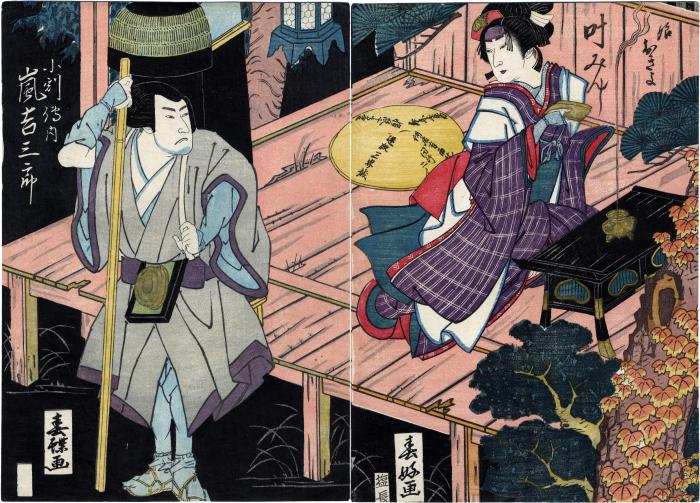Shunkōsai Hokushū (春好斎北洲)
(artist ca 1808 – 1832)
Katsukawa Shunchō (勝川春潮)
(artist 1783 – 1821)
Kano Minshi I (叶みんし) as Okiyo (娘おきよ) and Arashi Kichisaburō II (二代目嵐吉三郎) as Kowari Dennai (小割伝内) in the play Katakiuchi ura no asagiri (Revenge along the Bay in Morning Fog: 敵討浦朝霧)
09/19/1815
19.75 in x 14.125 in (Overall dimensions) Japanese woodblock print
Signed on the right panel: Shunkō ga (春好画)
on the left panel: Shunchō ga (春蝶画)
Publisher: Shioya Chōbei
(Marks 475 seal 25-093)
Philadelphia Museum of Art - the right-hand panel
Philadelphia Museum of Art - left-hand panel
Hankyu Culture Foundation - a related print to the left panel
Hankyu Culture Foundation - another interesting comparison by Hokkei from 1818
Hankyu Culture Foundation - right panel
Hankyu Culture Foundation - left-hand panel only
Royal Museums of Art and History, Belgium (via Cultural Japan) - left-hand panel only
Victoria and Albert Museum - right-hand panel only
Victoria and Albert Museum - left-hand panel only In Kabuki Heroes of the Osaka Stage 1780-1830 on page 157 it says: "Dennai was one of Rikan's most popular roles. He is a hunter who gets mixed up in a murder. The original story was based on a real incident in 1804, which involved the lord of Akashi and a hunter named Gennai. Nagawa Harsuke wrote this play specifically for Rikan to take the lead role.
The diptych print is an example of a 'joint production' (gassaku) between two or more artists. Such collaborations in multi-sheet prints were quite common in Osaka; in contrast to Edo, where they were rare."
****
There is something oddly unique about this composition. Not only is it a collaboration between two significant artists, something which had been done before, but the layout and the dramatic use of black contrasted with the pink of the engawa and the bright yellow of the onnagata's sedge hat seem to set it apart from other prints from this time.
Another point of interest is that the printer's seal does not appear in the oblong box reserved for it on the left panel. Of course, this is not unheard of, but still it is unusual for such an unusual composition.
****
In a later (1864), but older variant of this play's theme, Katakiuchi ura no asagiri (Revenge along the bay in morning fog), John Fiorillo and Hendrik Lühl wrote: "The story involved an attempted usurpation of the leadership of the Aboshi clan by a villain named Karahashi and his son. Dennai, a hunter and a relative oÍ the true heir, was sent to terminate the plot."
****
Illustrated in:
1) Ikeda Bunko, Kamigata yakusha-e shūsei (Collected Kamigata Actor Prints) Volume 1, Ikeda Bunko Library, Osaka 1997, no. 51.
2) Schätze der Kamigata: Japanische Farbholzschnitte aus Osaka 1780-1880, MNHA (Musée national d'histoire et d'art Luxembourg), 2012, p. 186, #390. The text reads:
"Der Jäger Dennai, hier verkleidet als Komuso (wanderender Bettelmönch), ist auf dem Wege nach Absoshi, und dort den Streit um die Führung des Oboshiklans zu schlichten. In einem Gasthaus trifft er auf das Mädchen Okiyo, seinen Verlobte, die er hier zum, ersten Mal sieht."
The Google translation reads:
"The hunter Dennai, here disguised as a Komuso (wandering mendicant monk), is on his way to Absoshi to settle the dispute over the leadership of the Oboshi clan. In an inn he meets the girl Okiyo, his fiancé, whom he sees here for the first time."
3) The Theatrical World of Osaka Prints there is a copy of this diptych in the collection of the Philadelphia Museum of Art. There is a small black and white illustration of the print on the left by Shunchō in that catalogue on page 249, #352. [See the links above.]
4) in color in Kabuki Heroes of the Osaka Stage 1780-1830, British Museum, 2005, page 157, no. 121.
****
This diptych is an example of gassaku (合作) or where more than one artist contributed to a composition. In this case it was separate sheets, but in other cases one artist might provide the figures and the other the background or some other motif element.
Shioya Chōbei (塩屋長兵衛) (publisher)
Kyōto-Osaka prints (kamigata-e - 上方絵) (genre)
actor prints (yakusha-e - 役者絵) (genre)
Kanō Minshi I (初代叶珉子: from 4/1801 to 10/1817) (actor)
Arashi Kichisaburō II (二代目嵐吉三郎: 1/1784 to 12/1820) (actor)
